 |
 | |
 |
| |
What will it look like? How will it work? I've got a great idea and
I want to test it out. First I need to decide what I want it to do.
Then I'll make a model and see if it works.
|
|
|
 |
| |
The person who says this is about to start designing. Designing is the
part of the innovation cycle that will turn the sum of your ideas and
research into a product, system or environment.
Design determines how an innovation works and looks, how people use it,
how it's made, what it's made from, even how it's packaged. At the end
of the line, design also determines how a product is disposed of - or
whether it can be recycled or reused.
The user reacts to design in two important ways: first by assigning all
sorts of values (like status, sexiness and desirability) to external appearance;
and second by assessing how performance measures up to expectation.
A designer needs to understand the practical and visual requirements
as described in the brief. Investigating possible solutions, modelling,
testing and evaluating the results ensure the final design meets as many
of these requirements as possible.
Design Institute of Australia http://www.dia.org.au/DIA2000menu.cfm
Design Council UK http://www.designcouncil.org.uk/design/
Exploring design and innovation http://www.brunel.ac.uk/research/exploring/home.html
|
|

|
| | Sydney 2000 Olympic Torch — a unique design project
The Sydney 2000 Olympic Games was an important event in
the history of Sydney and Australia. Sydney's infrastructure
and organisational abilities were under scrutiny from
all 199 nations (10 651 athletes) attending the Games.
The Games were declared the 'best games ever'. In addition
to the accomplishments of athletes in the stadium, there
were significant achievements in Australian design and
technology leading up to the Games. One of these was the
development of the Sydney 2000 Olympic Torch.
The torch featured many design and technology elements
that had not been used in earlier Olympic torches. Several
groups collaborated in its development. The exterior was
designed by Blue Sky Design, modelling was done by Box
and Dice and manufacturing by GA & L Harrington, all
based in Sydney. The innovative fuel combustion system
was researched and developed by Adelaide University and
Fuel & Combustion Technology Pty Ltd.
The torch received recognition around the country, including
an Australian Design Award. It became an icon of the Sydney
2000 Olympic Games and took its place in the collection
and exhibition of the Olympic Museum in Switzerland alongside
all other Olympic torches. The design of the torch was
integral to the innovation and to its impact.
| |
 |  |
| |
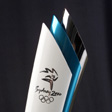 |
| The Olympic torch. Gift of the
New South Wales Government. Part of the Sydney 2000
Games Collection. |
|
|
Introduction
Celebrations erupted on 23 September 1993 when Sydney
was announced as the host city for the 2000 Olympic Games.
From then until the Games opened, many Australians worked
hard to make the Games succeed.
The torch relay is important in the lead-up to each Olympic
Games. Every relay begins when a sacred flame is lit from
the sun's rays in Greece. The flame then travels to the
host city, and its arrival signals the beginning of the
Games. The first torch relay of the modern Olympic Games
was conducted in 1936 in Berlin. It was inspired by ancient
Greek traditions described in drawings and writings.
The Sydney 2000 torch relay was the longest ever. The
flame travelled 27 000km from Greece to Sydney via several
Pacific islands and many towns in Australia. Cathy Freeman,
who later won an Olympic gold medal, was the last to carry
the flame and used it to light the Olympic Cauldron.
Every country that hosts the Games designs its own torch.
The Sydney Organising Committee for the Olympic Games
(SOCOG) wanted the torch to become an icon of the Sydney
2000 Olympic Games and represent Australia's skills in
manufacturing and design.
It is a policy of the International Olympic
Committee (IOC) that all aspects associated with the
Torch reflect the culture of the country hosting the
Olympic Games. It is considered imperative that Australian
organisations are involved in this design and development
process to assist in the promotion of Australia's future
vision and demonstration of local technical capabilities.
Olympic Torch Relay - Handheld Torch and Portable Cauldrons,
Invitation for Proposal, SOCOG, 1998.
Sydney Morning Herald Sydney 2000 Torch Relay news site
(archive) http://www.smh.com.au/olympics/torchrelay/
|
|
|
| |
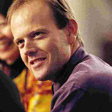 |
| Mark Armstrong. Courtesy Blue
Sky Design |
|
|
The
design brief
November 1998 SOCOG invited forty firms to participate
in the tender to design and manufacture the Olympic Torch.
One of the companies that responded to the tender was
Blue Sky Design, based in Sydney.
The Olympic torch was a piece of industrial
design that had a fascination for industrial designers.
Mark Armstrong, Creative Director, Blue Sky Design.
The torch design brief was a thorough document that outlined
the aesthetic and technical requirements for the torch.
The design had to embody the spirits of Sydney, Australia,
the athlete, Olympia, innovation and sustainability. It
had to be safe and easy to use, and stay alight even if
it was upside down.
The torch had to be simple, lightweight (less than 1.5kg)
and low in cost. It had to produce a highly visible flame
that would burn for at least 20 minutes with efficient
use of fuel and minimum emissions. The torch had to operate
in rain or hail, winds up to 65km/h and temperatures from
-5°C to 45°C. It would need to travel in different
environments and via different means of transport including
boat, bicycle, canoe and horse.
Production of 14 000 torches and 1000 commemorative torches
had to be completed by March 2000. Prototypes needed to
be ready in February 1999 to be launched in March 1999.
Our first response was to say, yes, this
was something we wanted to win, so we formulated a design
strategy to win the tender. In fact, it turned out that
winning the tender was the actual design process.
Mark Armstrong, Creative Director, Blue Sky Design.
|
|
|
| |
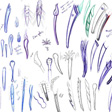 |
| Concept sketches for the torch design. Courtesy Olympic
Co-ordination Authority and Blue Sky Design. |
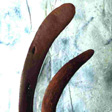 |
| The hunting boomerangs that inspired the designs |
|
|
The
innovation
The first step for Blue Sky Design in approaching the
Olympic Torch project was to assemble a team. The company
quickly formed partnerships with the best people in the
fields required. Blue Sky collaborated with RMIT University
Centre for Design to address the environmental aspects
of the torch design. Manufacturers GA & L Harrington
joined the collaboration along with Box and Dice model
makers. Blue Sky approached Phillips Electronics to provide
financial backing for the design and development process.
When you win a tender you have to have
a team with all the right skills. So that was how we
responded, was first collate the very best partners
we could, and have a winning team.
Mark Armstrong, Creative Director, Blue Sky Design.
Investigation
Blue Sky Design had never designed an Olympic torch before.
To understand the history and tradition of the Olympic
torch, the designers began by doing research. They analysed
the design and technology used in each of the previous
Olympic torches and learnt from problems other countries
had experienced. For information about Olympic torches
used before Sydney 2000, see the International Olympic
Memorabilia Federation http://www.collectors.olympic.org/e/fimo/fimo_torches_e.html.
To address the look described in the brief the designers
focused on the different 'spirits' suggested: of Sydney,
innovation, Olympia, the athlete and sustainability. Blue
Sky created image boards for each of the different aspects.
The spirit of Sydney included the Opera House sails and
the water of Sydney harbour. Innovation included the orbital
engine and the Victa lawnmower. The spirit of the athlete
was 'higher, faster, stronger'.
It's something of our culture with the
Opera House and the lightness. It had to be sporty like
a Kevlar racing bike. It had to be unique and surprising…
like a Sarich engine or a piece of biomedical equipment
… that's a little bit about Australia's culture
as well.
Mark Armstrong, Creative Director, Blue Sky Design.
These image boards helped to inspire the designers when
creating the initial design drawings. The senior designer
for the project was Robert Jurgens. He began by making
sketches to try and embody all the characteristics required
of the brief.
The designers looked for inspiration in natural and built
environments to help develop a strategy that would appeal
to the judging committee. Another significant influence
was the shape of the hunting boomerang that they had in
the studio as they were developing the designs.
[We wanted to] convey the curve of the
boomerang without making it too obvious.
Robert Jurgens, Senior Designer, Blue Sky Design.
All that stuff had to come out in the
early sketches, and then we modelled up four designs
in our tender because we weren't quite sure which way
to go.
Mark Armstrong, Creative Director, Blue Sky Design.
|
|
|
| |
 |
| The four designs submitted by Blue Sky. Courtesy Olympic Co-ordination
Authority and Blue Sky Design. |
|
|
Developing alternative solutions
Blue Sky Design submitted four designs with its tender
application. Each one addressed a different combination
of the design elements from the brief. The first design
had a high tech approach with a carbon fibre handle. The
second design was more traditional, with a wooden handle
and the Opera House sails in a cup around the flame. The
third design was inspired by the athlete and the shape
of a boomerang. The fourth design was symbolic, with the
outer layer representing the white sails of the Opera
House and the inner blue layer the waters of the harbour,
with the shape inspired by the hunting boomerang.
|
|
|
| |
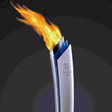 |
| The chosen design. Courtesy Olympic Co-ordination Authority and
Blue Sky Design. |
|
|
Choosing a solution
It took Blue Sky Design six weeks from receiving the brief
to submitting its proposal to SOCOG. It was chosen as
one of four submissions to progress to the final selection
round.
The designers focussed on one design in the final round.
From their interviews with the SOCOG committee, they decided
that the symbolic design would be the one that would most
satisfy the committee and the brief.
|
|
|
| |
 |
| The centre core of the model
was machined from a solid piece of aluminium. Courtesy
Box and Dice Pty Ltd. |
 |
| The plastic inner shell after vacuum forming. Courtesy Box
and Dice Pty Ltd. |
 |
| The shells were finished before being stuck together to form
the model. Courtesy Box and Dice Pty Ltd. |
|
|
Modelling
For the final selection round, Blue Sky Design decided
to produce a model. This was to help the selection committee
and the designers visualise the final product. Blue Sky
refined the torch design using computer-aided design (CAD)
and then emailed the CAD file to Box and Dice model makers.
Box and Dice machined all the parts for the model. The
centre core was made from aluminium and then used to form
the shape of the plastic inner and outer shells. The model
makers Allan Ismay and Rick Perrior decided that when
the three layers were put together the torch looked too
long. They also decided that the angles of the layers
at the top of the torch didn't look right. So in discussion
with Mark Armstrong they changed the design as they modelled
it, making it shorter and changing the angle of the outside
layer so more of the blue layer could be seen. The outer
surface of the torch was treated using a water-based printing
process that created layers and textures on the surface.
We knew we had to have an exotic surface
- just to have anything… because just to have a
metal shape, or a plastic shape is nothing… we
were searching for finishes and materials that we could
embody the design with, and enrich it.
Mark Armstrong, Creative Director, Blue Sky Design.
The model weighed about 5 kg. Box and Dice hollowed out
the aluminium core and inserted a grille in the top to
simulate a burner. The three sections were glued together,
a traditional model-making technique. Box and Dice made
a clear plastic stand in the shape of a hand to present
the torch to the Committee.
Blue Sky Design presented the model to the SOCOG Torch
Review Committee, along with a lifecycle analysis of the
torch and documentation about emissions, flame burn and
manufacturing costs. The design was sent to the International
Olympic Committee for approval, and Blue Sky was selected
as the firm to continue with the torch design and development.
The winning design, conceived by Blue Sky Design senior
designer Robert Jurgens and creative director Mark Armstrong,
was unveiled in March 1999.
|
|
|
| |
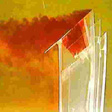 |
| The perspex torch model being tested in a water tunnel. Courtesy
Adelaide University Turbulence, Energy and Combustion Group.
|
 |
| The effect of wind on the torch flame. Courtesy Adelaide University
Turbulence, Energy and Combustion Group. |
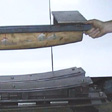 |
| The wooden punch and steel die used to make prototypes for testing.
Courtesy GA & L Harrington. |
 |
| This draw die was used to form the torch shape during manufacturing.
Courtesy GA & L Harrington. |
|
|
Testing
Adelaide University and Fuel & Combustion Technology
Pty Ltd (FCT) were commissioned by SOCOG through a separate
tender process to develop the burner system for the torch.
Through an extensive research and development process,
they created a system that resulted in a new patent. The
torch was prototyped and tested intensively to ensure
it satisfied the technical requirements within the constraints
of the exterior design. The torch shape was tested in
a water tunnel to check its aerodynamics. The shape of
the flame and its ability to stay alight in different
environments were also tested. The manufacturer, GA &
L Harrington, was closely involved in the prototyping
process. For more information about the design and development
of the burner system see Turbulence, Energy and Combustion
Group at university of Adelaide http://www.tec.adelaide.edu.au
Manufacturing
Once the torch design had been selected, GA & L Harrington
began the manufacturing process. This presented challenges
because there were no engineering drawings to work from.
The engineers had to use the model made by Box and Dice,
along with the design brief, to identify potential problems
and solutions for the manufacture of the torch.
The problems they had to overcome included the difficulty
of forming the three curved shells of the torch in the
chosen materials, particularly the stainless steel inner
layer. The middle and outer layers were made from aluminium.
Fitting the three shells together and producing the correct
colours and texture finishes was also difficult. Special
micro-machining techniques were developed to manufacture
the choke that regulated the gas flow in the torch. The
torch design was fine-tuned in consultation with Blue
Sky to ensure the combustion system fitted inside the
torch. For more information about how GA & L Harrington
solved these problems see http://www.galharrington.com.au/torch.htm.
|
|
|
| |
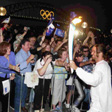 |
| Pat Rafter with the Olympic torch in front of the
Sydney Harbour Bridge and Olympic rings. This was
a fantastic promotional opportunity for the Sydney
2000 Olympics and an exciting moment for the crowd.
Photo by Mike Keating. Copyright News Limited -
www.newsphotos.com.au. |
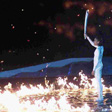 |
| The Olympic torch design project culminated in the
dramatic lighting of the Olympic cauldron by Cathy
Freeman at the Sydney 2000 Olympics Opening Ceremony.
Copyright News Limited - www.newsphotos.com.au. |
|
|
The
impacts
Olympic torches were carried by 10 000 people in Australia
and another 2 000 in Oceania and Greece. The flame and
torch travelled through all states to within a one hour
drive of 85% of the Australian population. As the torch
travelled through the country, 188 community festivals
were staged around community cauldrons lit by the flame.
The torch relay began on 12 May 2000 and finished on 15
September 2000 when the Olympic cauldron was lit and the
Sydney 2000 Olympic Games began.
The torch relay created excitement and anticipation in
the lead-up to the Games. Some of the design team were
given the opportunity to run in the relay, including Mark
Armstrong and John Harrington. Mark Armstrong was amazed
to see the effect the torch had on the crowd. People clamoured
to hold the torch and have their photograph taken with
it. The torch was a powerful tool for building enthusiasm
for the Sydney 2000 Olympic Games.
I was shocked … that people could
just be so caught up in a flame on a stick. It's still
just a piece of industrial design, it's a piece of engineering,
it's a nice looking thing, that's it. But… when
I was there in the torch relay I really had a lump in
my throat. It was just incredible to see how much it
meant to other people, which I didn't realise.
Mark Armstrong, Creative Director, Blue Sky Design.
The Olympic Torch won an Australian Design Award in 2000
for Industrial Design. The SOCOG committee was so impressed
with the design process used for the torch that it requested
the same team of people create the community cauldrons
and the Sydney 2000 Paralympic Torch.
This outstanding collaboration has resulted
in a finely resolved and ergonomically sound product,
which meets both the technical and symbolic requirements
of the brief.
Judges' citation for the Australian Design Award for
Industrial Design 2000.
For us at Blue Sky the project has been very special
and uplifting. The team just "clicked" and
each member from the designers to the production engineers
has demonstrated a passion for the project which is
quite extraordinary.
Mark Armstrong, Creative Director, Blue Sky Design.
ABC Torch Relay Archive — Stories about people's
relay experiencehttp://http://abc.net.au/torch/
Newsphotos Torch Relay Photo Archive http://www.newsphotos.com.au/
|
|
|
| |
Links and references
Blue Sky Creative http://www.blueskycreative.com.au/default.html
Box and Dice http://www.boxanddice.com.au
GA & Harrington http://www.galharrington.com.au/indexl.html
Turbulence, Energy and Combustion Group at University
of Adelaide http://www.tec.adelaide.edu.au
FCT International http://www.fctinternational.com
Australian Design Awards http://www.designawards.com.au/ADA/99-00/INDUSTRIAL%20DESIGN/030/030.HTM
The Lab — Olympic Torch Technology http://www.abc.net.au/science/slab/torch/default.htm
ABC Torch Relay Archive — Stories about people's
relay experience http://http://abc.net.au/torch/
Newsphotos Torch Relay Photo Archive http://www.newsphotos.com.au/
Powerhouse Museum Sydney 2000 Games Collection http://www.phm.gov.au/sydney2000games
Exploring design and innovation http://www.brunel.ac.uk/research/exploring/home.html
Design Institute of Australia http://www.dia.org.au/DIA2000menu.cfm
Design Council UK http://www.designcouncil.org.uk/design
True-blue design, the story of Australia's Olympic Torch', MultiCAD
Magazine, Vol 8 No 5 June 2000 http://www.quantumbooks.com/Creativity.html
TAS August 2000 Forum', The Australian Standard, Standards Australia International Ltd, August 2000 http://www.quantumbooks.com/Creativity.html
'True-blue design, the story of Australia's Olympic Torch',
MultiCAD Magazine, Vol 8 No 5 June 2000 http://www.echomags.com.au/torch.htm
'TAS August 2000 Forum', The Australian Standard, Standards
Australia International Ltd, August 2000 http://www.standards.com.au/
Australian Design Awards, Australian Design Awards
Yearbook 2000, Standards Australia, 2000.
SOCOG, Olympic Torch Relay - Handheld Torch and Portable
Cauldrons, Invitation for Proposal, 1998.
Unpublished, Powerhouse Museum interview with Mark Armstrong,
15 January 2002.
Unpublished, Powerhouse Museum interview with Mark Armstrong
and Robert Jurgens, 1 November 2000.
Key people, jobs and skills
Professor Chris Ryan, Environmental Design Specialist,
RMIT University Centre for Design.
Mark Armstrong, Creative Director, Blue Sky Design
Robert Jurgens, Senior Designer, Blue Sky Design
Ian Cameron, Engineering Development, Blue Sky Design
Alan Ismay, Principal Model Maker, Box and Dice
Rick Perrior, Principal Model Maker, Box and Dice
John Harrington, Managing Director, G. A & L Harrington
Norm Smith, Prototype Manufacturer, G.A & L Harrington
Dr Gus Nathan, Project Leader, Adelaide University/FCT
Dr Richard Kelso, Chief designer, Adelaide University/FCT
Prof Keith D King, Chief designer (fuels), Adelaide University/FCT
Di Henry, Torch relay manager, SOCOG
Joseph Buhagiar, SOCOG
Jobs and skills required
Designer
Model Maker
Mechanical Engineer
Chemical Engineer
Manufacturing Engineer
Marketer
Negotiator
Team Leader
Production Line Worker
Office Manager
Personal Assistant
Discussion questions
K-6
1. What is a torch? What is a cauldron? Draw a torch.
Draw a cauldron.
2. What is an Olympic Torch and what is it used for?
3. The flame on the torch is fuelled by a gas. What are
some of the dangers of using this kind of fuel? What safety
precautions can we take when using flammable gases?
4. Collect samples of aluminium, stainless steel, wood
and plastic and identify those materials which can be
recycled. How many of these materials can be found in
the Olympic Torch?
7-10
1. How important was the team or collaborative approach
to the final design of the model?
2. What is meant by the life cycle of a product? Why was
an analysis of the torch's life cycle considered an important
component of the presentation to the SOCOG Torch Review
Committee?
3. Discuss why you think the Torch was an important marketing
tool for building enthusiasm for the Games.
4. Research ancient Greek traditions which describe the
use of a torch or flame. What was the significance of
fire to the ancient Greeks?
11-12
1. What is a tender? Outline the differences between an
open tender and a selected tender. What advantages would
there be in inviting 40 firms to participate in the tender
process? What kinds of research would be required for
SOCOG to make their selections? What issues might arise
in an open tender?
2. Blue Sky selected one out of four original designs
submitted to progress to the final selection round. How
did they decide which design to develop? Imagine that
you are interviewing SOCOG committee members to work out
what kind of design would be most successful. What kinds
of questions would you ask?
3. For what is CAD an acronym? What is CAD? What kinds
of professionals use it? For what purposes and in what
situations?
4. Write a brief for the design of a new product. Consider
the aesthetic, technical, safety and environmental requirements.
| |
|
 |
  |
|
|
|


























